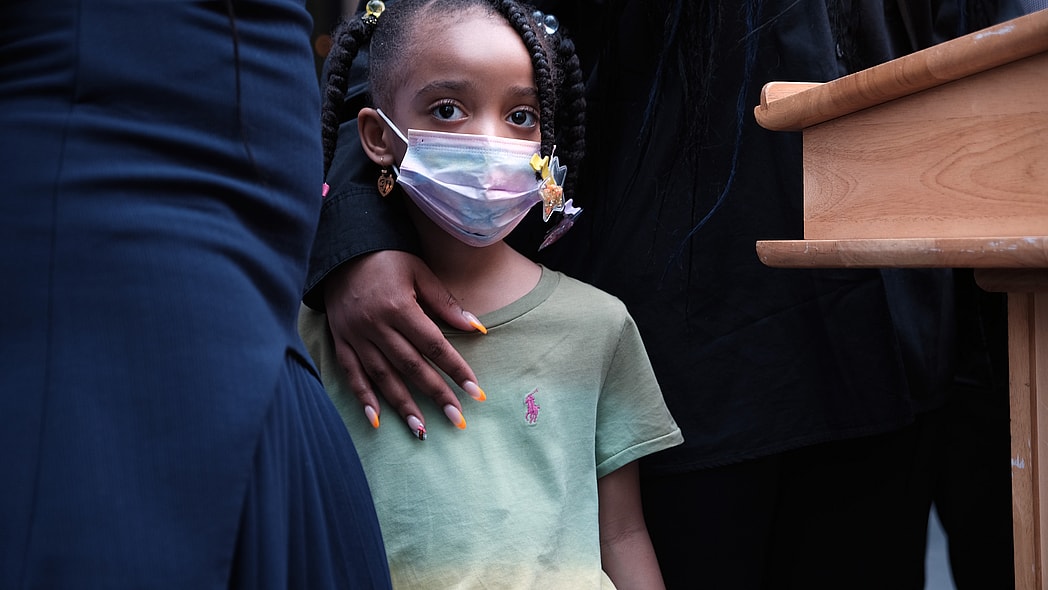Editor’s note: The following article is an op-ed, and the views expressed are the author’s own. Read more opinions on theGrio.
Being a parent can be a difficult job. Of course, it’s a joy watching your children grow; the internal moments spent watching and molding our children into their future selves make all of the sleepless nights (which, trust me, do not end just because your child is a toddler or older) and high-stress moments worth it. But there’s the other part; the part where your child has to interact with the world that we try to shield them from for as long as possible, the part that threatens their innocence; the part where we have no control. And that world can look different for Black parents and parents of color. There are racial and social landmines that we know our children will have to encounter and sidestep over time—especially in America—but we all hope it doesn’t happen in spaces that seem specifically curated to maintain the happiness of their childhood. And yet.
That’s why the Instagram clip that circulated this past week of the two little Black girls at Sesame Place who were ignored, shunned or simply rejected by the person dressed as the Muppet character “Rosita” struck a nerve, ESPECIALLY for Black parents. It is infuriating, as a parent, to have to witness your child being shunned by anybody. But being rejected by a character that they know and love from one of the shows that nearly all of Black America has spent years consuming SPECIFICALLY because of its warmth and familiarity? And then having to stuff down the immediate anger in order to hopefully redirect your child’s emotions so they don’t realize what just happened to them or are distracted enough to forget it??! It’s exhausting—but more importantly, who in their right mind treats little kids like that at a place you specifically bring your kids to BECAUSE it’s all about the kids?
Sesame Place, the theme park where this all happened, is so named because of Sesame Street, the long-running educational PBS show that was created with inner-city children in mind. I remember watching Sesame Street as a child and even though I didn’t register it the way I do now, I saw people who looked like my parents and sang songs and danced and jammed like my family. Sesame Street wasn’t a show that was only for inner-city children; it’s a world-famous show accessible to people from all walks of life. But it was created with the intent of ensuring that inner-city children—Black and brown children in New York City; the brownstone background is Harlem all day long—saw a bit of themselves on television, providing a relatable palate to learn from. And it worked.
I’m not saying Sesame Street raised all of us, but every Black person I knew growing up watched Sesame Street; Gordon and Luis (among others) were just as much part of the family as Big Bird, Oscar the Grouch and the big homie, Mr. Snuffleupagus. To watch Sesame Street is to watch your TV family help you navigate ideas, situations and learn at the same time. And Black folks love a good educational program.
So when we take our kids to places like Sesame Place, we’re doing so because of the nostalgia and the space that Sesame Street has taken up in our lives. Parents trust the brand and trust the space; it’s not as if it’s free, but we’re willing to pay a premium to be in spaces that have contributed to our children’s lives. It’s why these very spaces even exist; parents trust the brands to care about the experiences of their children. It’s why that clip and the aftermath have been puzzling and created such an uproar. It’s Sesame Street! Our kids are there excited to see the very characters they see on television who teach them lessons. And they’re even MORE excited when those characters walk around and give them hugs and high-fives.
Here’s a thing to note about little children: while they do love the characters on TV, seeing a 6-foot version of this furry monster can be scary for them. But when they see other kids excitedly hugging and high-fiving their favorite character, they build up confidence and just might try to push aside that fear so their favorite character—almost always Elmo—can hug them and make their day. I don’t know if that’s the reality for those two little girls. There’s a lot that isn’t shown in a 10-second clip intentionally posted on Instagram to make a point.
But there is a lot you can gain from that video. You see Rosita high-fiving little kids. You see her walk towards the little girls, who Rosita CLEARLY saw. You see Rosita finger “no-no” to somebody in the background who isn’t visible on that screen and THEN you see Rosita basically say “no” and move on from the little girls, whose arms are outstretched and are excitedly looking forward to an interaction. Instead, they were slighted. Shunned. Actively rejected. And that’s the part that has pushed that video being viewed over 9 million times.
Any parent can take a look at that video and see two little kids being unnecessarily rejected by a beloved character. But Black parents also see the little white kids who got high-fives and because of our history with these sorts of things, you can’t help but wonder if those little Black girls, in particular, were ignored. And that’s what sends Black parents into hyperdrive and why so many other videos have surfaced online of characters shunning little Black kids.
That’s also why Sesame Place’s first statement was such nonsense, and why they ultimately had to draft a second. That first statement was textbook gaslighting, a gaslighting Black America knows all too well. The statement essentially said, “Hey, you didn’t see what you think you saw; what really happened was this, so it’s not personal or about you at all. We asked and our employee confirmed that we think we’re right. We said ‘my bad’ and told the family they can come back on us.”
Every Black person knows that response; America has been telling us that what we know to be true through experience is neither a thing nor has it ever existed. But social media is an engine that purrs, and Black people who organize on social media over slights to our children aren’t inclined to let such gaslighting go unchecked. Which is clearly why Sesame Place released a second statement that was much more pointed and action-oriented—plus, it’s hard to ignore ALL of the videos that surfaced amid the event hitting the news cycle. The second statement was much better. They acknowledged they need to do better, that they learned something and that they need to make sure all patrons are able to enjoy the same experience and that they need to do training to ensure that. Is it great? No. But it’s better than telling people that their kids weren’t actually wronged when we know what we saw.
I’m a father of four kids and my wife is the co-founder of District Motherhued, an organization that caters to millennial moms of color in the Washington, D.C., area. Because of District Motherhued, I have a Dad’s Chat group where we often talk about things happening so I posed some questions to the chat and asked my wife to do the same in her group: What would you have done in that moment and what would you say to your kids in response?
The responses varied, of course, but I think we all agreed that in the moment, no matter how annoyed or upset we’d be, the first order of business would be to attempt to dull the impact of the negative interaction on our children. Finding a new character to high-five or hug, or making it seem like maybe the character just missed them. The goal, however, is to lessen the blow (and permanent memory) for the child. Sadly, according to TMZ, that permanent memory is one the family in the viral post is now attempting to work through.
I think we’d all want to do exactly what Kelly Rowland alleged she would’ve done—“burned the place down.” But as mad as I’d be in the moment, my kid’s peace would overrule any large-scale actions. That is also why I’m happy the mother of those children took it to social media: Those little Black girls were negatively impacted and now she has to deal with the potential of a lost space of innocence for her kids. Will Sesame Street now trigger her kids??? In what world is that OK? It’s Sesame Street.
In my opinion, making the moment go viral was the smart course of action. Ultimately, it revealed other people have had similar experiences, though seemingly isolated, but have turned out to be emblematic of a certain pattern of behavior by certain characters (specifically, whoever is donning those costumes). The last thing Sesame Street—or Sesame Place needs is a ton of negative publicity.
The big question remains: how to explain and help your kids process their experience. Was it racial? Did the kids notice that the white kids got interactions? Do you point out to them that the white kids did? I’m not sure I’m personally ready to distinctly point out the differences in a “you were treated in a less than” capacity yet. I’d be more inclined to explain that Rosita made a bad decision that was about Rosita and she should watch more Sesame Street to learn how to make good choices.
But as my wife and I polled our groups, some other parents did make mention of it being an opportunity to point out the racial dynamics at play. It should be pointed out that the ages of the folks’ kids in question vary, so an older kid might internalize the racial part, whereas the younger kids’ feelings are just hurt because they were rejected. Like most situations in life where race could be part of the problem, the solutions are nuanced. I just know that it sucks to HAVE to be concerned about that in the first place.
I shouldn’t have to have a racial reckoning conversation with my kids because I took them to a physical re-creation of Sesame Street. I think my kids’ feelings would be devastated but I also think some well-timed ice cream and getting a high-five from another character would fix it in the short term, while my Twitter fingers got to work firing off a missive about unfair and inequitable treatment at the theme park.
What’s most unfortunate about all of this is that those little children had to have an experience they didn’t deserve from a person wearing a costume who perhaps should learn what their job entails. If you can’t hug all the kids or high-five them all, then don’t high-five them at all, and definitely don’t reject kids with outstretched arms. Sesame Street is good for teaching kids lessons; one of them shouldn’t be how to get over being rejected at Sesame Place.

Panama Jackson is a columnist at theGrio. He writes very Black things and drinks very brown liquors, and is pretty fly for a light guy. His biggest accomplishment to date coincides with his Blackest accomplishment to date in that he received a phone call from Oprah Winfrey after she read one of his pieces (biggest) but he didn’t answer the phone because the caller ID said “Unknown” (Blackest).
Make sure you check out the Dear Culture podcast every Thursday on theGrio’s Black Podcast Network, where I’ll be hosting some of the Blackest conversations known to humankind. You might not leave the convo with an afro, but you’ll definitely be looking for your Afro Sheen! Listen to Dear Culture on TheGrio’s app; download here.


